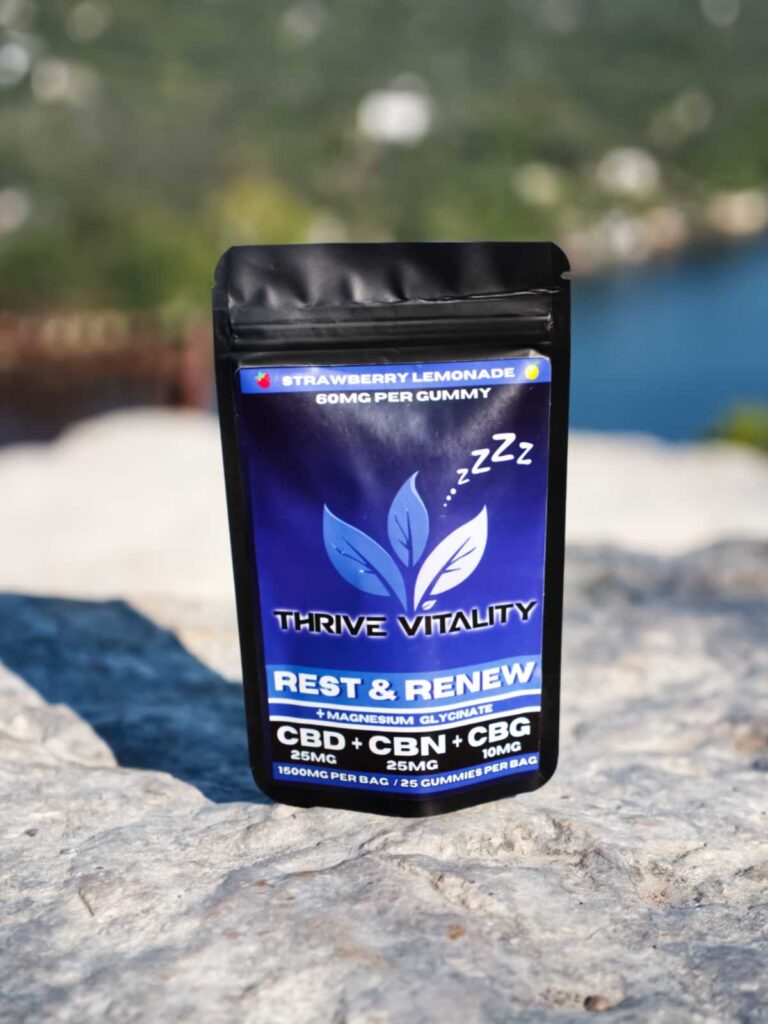Cannabinol (CBN) vs CBD for Sleep, Effects of CBN, and Sleep Quality
CBN has become the most talked-about cannabinoid for sleep — but does it actually work? Sleep-focused cannabis products are booming, and CBN is leading the charge.
This lesser-known compound forms naturally as cannabis ages and is now found in gummies, oils, and softgels. New research is starting to back its role in sleep health

Table of Contents
Headline Takeways
- Evidence in humans is limited but improving. One 2024 randomized, double-blind, placebo-controlled trial found 20 mg CBN nightly for 7 days reduced nighttime awakenings and overall sleep disturbance vs. placebo; effects on sleep onset and WASO were not significant.
- Preclinical work in 2024–2025 shows CBN (and its metabolite 11-hydroxy-CBN) can increase total sleep and alter sleep architecture in rodents, offering a plausible biological basis. .”
This section breaks down how cannabinol (CBN) and CBD relate to sleep—using plain language backed by real research. It covers what human trials show, what animal studies reveal about sleep stages, how dosing has been tested, and what those findings mean for sleep quality and next-day focus.
Expect clear guidance on using CBN, key safety points, and concise answers to common questions. The approach stays steady: low hype, strong science, and practical details that matter.
What is Cannabinol (CBN)?
CBN (cannabinol) is a cannabinoid found in cannabis plants. It forms naturally when THC breaks down over time through oxidation-which is why you’ll often hear that CBN is produced as cannabis ages.
CBN will be sold as either pure isolate or in broad-spectrum blends. At typical doses, CBN doesn’t produce a “high.”
The reputation of CBN as a powerful sedative comes mainly from small, older studies and lots of personal stories-but as you’ll see below, newer research tells a more nuanced story.
CBD vs CBN

CBD and CBN are both non-intoxicating at standard doses, yet they appear to influence sleep in distinct ways.
Research on CBD and sleep remains mixed—at lower or moderate amounts, it may even promote alertness rather than relaxation.
CBN, meanwhile, has shown early promise. In a recent controlled trial, 20 mg of CBN taken nightly was linked to fewer nighttime awakenings and reduced overall sleep disturbance.
A key point to keep in mind: many products marketed for sleep combine CBN with THC, which changes the experience and can increase side effects such as next-day grogginess. Always check product labels to confirm what cannabinoids are included and at what amounts.
How CBN May Affect Sleep (Effects of CBN)
Rodent EEG work shows CBN increased total sleep time and shifted sleep architecture. Researchers also saw a key piece: the primary metabolite of CBN, 11-hydroxy-CBN (11-OH-CBN), reached high brain levels and had clear receptor activity.
Signals in rats point to changes in NREM sleep and REM sleep that could explain a “sleepy” feel in folks. Early on, CBN even initially increased EM sleep before boosting total sleep classic biphasic effects you also see with other agents.
CBN and Sleep: What Human Studies Show
A study conducted by Bonn-Miller and colleagues ran a double-blind, randomized, placebo-controlled design over 7 nights. Adults with self-rated poor sleep took 20 mg CBN alone or CBN with CBD at several doses, or placebo.
CBN on its own was linked to fewer nighttime awakenings and less overall sleep disturbance than placebo. However, there wasn’t much change in how quickly people fell asleep or how long they stayed awake after first drifting off. Altogether, the results point to something practical: CBN may help you stay asleep more consistently, even if it doesn’t make you fall asleep faster. PubMed
Key Result: 20 mg CBN Nightly
The main takeaway is straightforward: taking 20 mg of CBN each night for one week was linked to fewer nighttime awakenings and lower overall disturbance scores. There was no clear change in daytime fatigue, time to fall asleep, or wake after sleep onset (WASO). The effects were modest but meaningful—especially for people who tend to wake up often during the night.PubMed
The ‘CUPID’ Protocol: Sleep and Next-Day Function

The CUPID study protocol (BMJ Open) is a crossover trial testing 30 mg and 300 mg of CBN against a placebo in people with insomnia disorder. It uses polysomnography to capture detailed sleep architecture and includes next-day assessments of alertness and function. The results from this study will be crucial for understanding how different CBN doses affect sleep onset, wake after sleep onset (WASO), and overall sleep quality using precise, lab-based measurements..BMJ Open+1
Sleep Architecture
In controlled EEG studies on rodents, CBN increased both NREM and REM sleep and extended total sleep time. Researchers also noted changes in sleep-bout duration. The study mapped CBN’s pharmacokinetic profile, showing that its metabolite, 11-hydroxy-CBN (11-OH-CBN), built up in brain tissue and showed strong receptor activity. Interestingly, these effects differed from those of the sleep medication zolpidem—CBN influenced REM sleep, while zolpidem did not. Together, the findings suggest that CBN acts through distinct cannabinoid pathways that uniquely shape sleep patterns. PubMed
Effect on Sleep vs Sleep Quality

It helps to think of CBN’s effects on sleep in two lanes. The first is objective sleep, measured through lab tools like PSG and EEG—this is where animal studies currently lead and where the upcoming CUPID human trial is focused. The second is subjective sleep quality, based on personal reports. That’s where the 7-night human RCT fits, showing fewer awakenings and less disturbance with 20 mg of CBN each night. In short, there’s a strong laboratory signal for CBN’s effect on sleep architecture and a modest but encouraging human signal for improved sleep quality. More detailed, night-by-night PSG studies in people will help close that gap. PubMed+1
Taking CBN: Timing, Form, and CBN Oil Basics
CBN oil, softgels, and gummies are the most common forms available. Most people take CBN 30 to 90 minutes before bed to match the typical absorption time for oral cannabinoids. The best approach is simple: start low, go slow, and give it a few nights to notice any effect.
Always look for third-party testing and clear labeling that lists the exact milligrams per serving. If a product combines CBN with THC, expect stronger sedation and a higher chance of next-day grogginess, since THC can affect alertness.
When it comes to CBD + CBN blends, keep expectations realistic—the seven-night human trial found no added benefit from pairing CBD with 20 mg of CBN. PubMed
Sleep Aid Context: Where CBN Fits
The American Academy of Sleep Medicine (AASM) emphasizes established methods such as CBT-I (Cognitive Behavioral Therapy for Insomnia) and, when appropriate, carefully prescribed medications for chronic insomnia. CBN is not currently included in AASM treatment guidelines, so its use for sleep remains experimental.
If you choose to try CBN, pair it with strong sleep habits—consistent bedtime, reduced caffeine, and proper light exposure—and consult a healthcare professional, especially if you have a diagnosed sleep disorder like sleep apnea.AASM+1
Sleep Disorder Caveats
If you snore loudly, stop breathing during sleep, or wake up exhausted every day, get evaluated for sleep apnea. For ongoing insomnia, CBT-I remains the first-line approach. CBN shouldn’t replace medical care—it’s best viewed as a natural supplement you can experiment with to improve sleep continuity, especially if you wake up often during the night. Focus on the basics first: a steady sleep schedule, healthy light exposure, limited caffeine, and stress management.. AASM
FAQs: CBN for Sleep, Dose, REM/NREM, and more
Does CBN Improve Sleep Quality?
A recent randomized, placebo-controlled study found 20 mg CBN nightly cut awakenings and overall sleep disturbance. Effects on sleep onset latency and WASO were not clear. PubMed
What About REM Sleep and NREM Sleep?
EEG work shows cbn increased total sleep time and raised NREM and REM sleep. That gives a mechanism signal. PubMed
In Summary
CBN forms naturally as cannabis ages and has become a common ingredient in products marketed for sleep support. Recent human research suggests that 20 mg of CBN alone may help reduce nighttime awakenings and overall sleep disturbance, though it doesn’t appear to speed up sleep onset.
Animal studies back this up by mapping how CBN and its metabolite, 11-hydroxy-CBN, influence both REM and NREM sleep, offering a likely biological reason behind its calming reputation.
If you decide to try CBN, start with a low dose, check product labels carefully, and maintain solid sleep habits—consistent schedule, low caffeine, and a relaxing bedtime routine.









